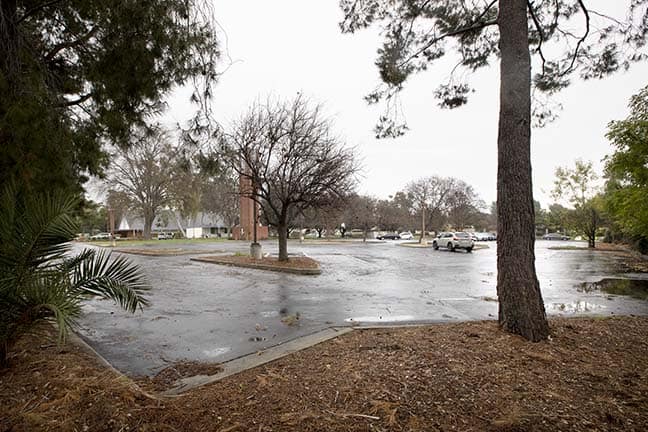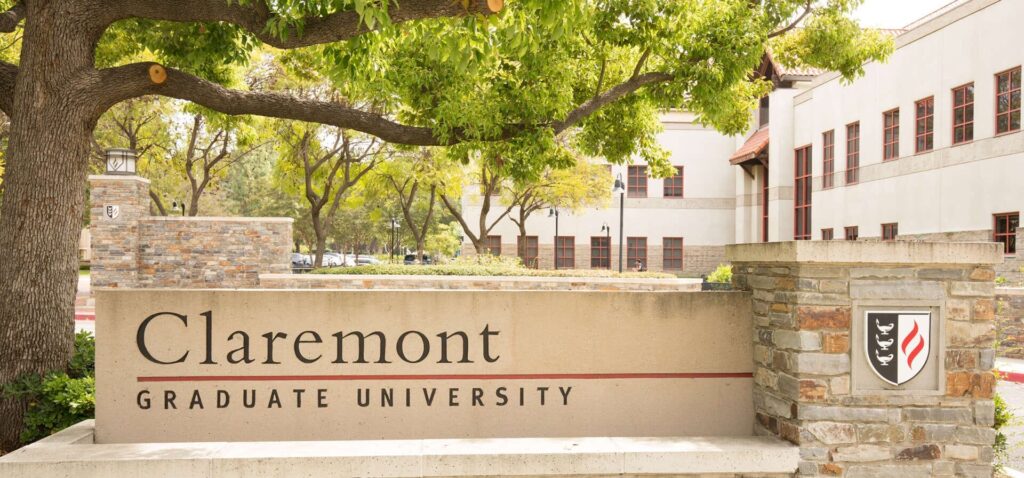Law would streamline housing construction at churches

A bill currently moving through the state legislature would make it easier for religious institutions to develop underutilized land. The southernmost portion of Claremont United Methodist Church, seen above, is one of the sites that could be developed. COURIER photo/Steven Felschundneff
by Steven Felschundneff | steven@claremont-courier.com
The vast parking lots and other underutilized land at many of Claremont’s religious institutions have long been viewed as potential locations for badly needed affordable housing, and a new bill working its way through the state legislature could make it easier to make it happen.
As church attendance rates have dropped over the years, religious institutions statewide have sought ways to develop their land, but face tremendous obstacles including the high costs of construction. Now, many are hoping Senate Bill 4will help them break ground, turning “NIMBY,” or “not in my backyard,” into “yes, in God’s backyard.”
Senate Bill 4 would allow 100% affordable housing to be built “by right” at religious institutions and certain nonprofit schools as long as projects meet established objective building standards. In addition, the approval process could be managed completely by the host city’s planning staff, avoiding the lengthy cycle of commission and council meetings. The housing projects would not be required to conform with existing zoning and could not be derailed by environmental impact lawsuits.
Introduced in December by housing advocate Senator Scott Wiener (D-San Francisco), SB 4 is the latest attempt to get a religious institution carve out from existing state housing law. Similar bills were killed during the previous two legislative sessions, in part due to opposition from construction trade unions that wanted guarantees that union labor would be a requirement for any project that sidestepped local zoning and established land use rules. This bill may be the golden ticket, however, because the California Council of Carpenters is a co-author even as other powerful labor councils continue to oppose the law.

St. Ambrose Episcopal Church, seen above, is among the religious institutions that have been identified by the City of Claremont and the state as prime locations for affordable housing. Senate Bill 4 would streamline the approval process for building on church property. COURIER photo/Steven Felschundneff
A May 2020 policy brief from the Terner Center for Housing Innovation at the University of California Berkeley estimated 38,800 acres of land at the state’s religious institutions could potentially support new housing development, including in some of the state’s highest-cost counties. Much of that land, including sites in Claremont, is considered “high opportunity neighborhoods” because of low poverty rates as well as being close to jobs, good schools, public transportation, and shopping.
“The research shows there are opportunities to support the goals of faith-based organizations as they grapple with the best use for their underutilized land and make progress towards California’s goals in building more housing, expanding access to opportunity, and reducing commute-related greenhouse gas emissions,” according to the Terner Center brief.
“Building affordable housing on our property has been a dream on the table for several years at St. Ambrose,” said Jessie Smith, pastor of St. Ambrose Episcopal Church. “We are in the early stages of working with a developer, and with the proposed Senate Bill 4 we are thrilled that this process may get even more streamlined.”
Smith said the church plans to offer affordable housing to seniors and families, not permanent supportive housing like at Larkin Place, which has been proposed for a site nearby on Harrison Avenue. The project would be constructed south of the existing church buildings and adjacent to existing apartment complexes, including one for seniors.
Providing housing aligns with St. Ambrose’s strong commitment to working with the unhoused community while simultaneously putting a valuable asset — its land — to better use, Smith said.
The project could help Claremont reach its housing targets set by the state. The city is currently in the process of updating its housing element, including demonstrating a plan to build 1,711 housing units, of which 556 must be for very low income, 310 for low income and 287 moderate income residents. The draft housing element document, available on the city’s website, identifies the 1.43 acres at the back of the St. Ambrose property as a potential site for new construction.
The city has identified 40 properties as “opportunity sites” as part of the draft housing element, six of which are religious institutions. This includes a .86 acre portion of the Claremont Methodist Church located off the frontage road along Foothill Boulevard. This plot of land is currently lightly landscaped and many residents will recognize it as the spot where the church erects its sometimes controversial Nativity displays.
The site is located close to shopping and services at the Old School House development and is close to transportation at the busy corner of Foothill and Indian Hill boulevards.
“The church has indicated to the city an interest in developing an affordable housing project on this vacant underutilized portion of their property in keeping with the church’s mission,” according to a city planning staff report.
“[Senate Bill 4] will offer immediate help streamlining badly needed affordable housing,” said Claremont City Council member Jed Leano, who is a strong advocate for building more of such housing in Claremont. “The Terner Center estimates that SB4 can unlock almost 40,000 acres of land for affordable housing. I look forward to us saying ‘Yes, in God’s backyard,’” Leano said.










0 Comments